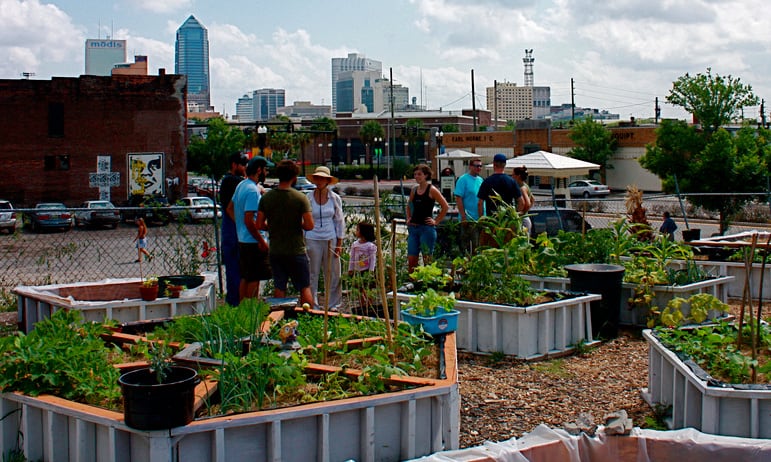The Facts About City Blooming Uncovered
The Facts About City Blooming Uncovered
Blog Article
The smart Trick of City Blooming That Nobody is Discussing
Table of ContentsEverything about City BloomingWhat Does City Blooming Do?The 5-Second Trick For City BloomingSome Known Factual Statements About City Blooming The Definitive Guide for City Blooming
Fascinated in expanding food up for sale in the City of Chicago? Considering beginning a neighborhood yard? Adjustments to the Chicago Zoning Statute permit agricultural uses like neighborhood yards and city ranches in several parts of the city. Below is a list of often asked concerns relating to the regulations and guidelines that cultivators should consider when intending an urban agriculture project.
The zoning modification does not customize any type of other codes managing composting, building permits, acquiring or leasing City owned property, business licenses or ecological contamination. There are existing codes that control these problems and they continue to be in full result and may be relevant to your job. Area yards are normally owned or handled by public entities, public companies or community-based companies and maintained by volunteers.
Urban farms expand food that is intended to be marketed, either on a nonprofit or for-profit basis. Due to their commercial objective, urban farms call for a company license.
The 10-Minute Rule for City Blooming
The amount of garden compost product can not exceed 25 cubic backyards at any kind of given time according to the standards in 7-28-715 of the City's Municipal Code. Since the soil at the majority of brand-new yard websites needs modifying, garden compost, dirt, timber chips, or various other materials can be gotten to create or boost the expanding room.

If a structure license is needed after that the hoophouse will certainly be considered an accessory building. You can discover more about the structure permit requirements by speaking to the Division of Structures. The 25,000-square-foot dimension limitation is planned to avoid a single community garden from dominating a provided block or interfering with the block's existing residential or commercial character.
The limit does not apply to yards found in Public Open Area (POS) districts. Can there be more than one area yard that is 25,000 square feet on a solitary block? Secure fencing is not needed, nevertheless, yards that have big parking areas might be required to mount fencing or other landscape design features.
City Blooming Fundamentals Explained
B1 & B2 districts call for that all commercial usage activities be performed inside your home. R areas limit commercial activity. The guidelines reflect the purpose and intent of the Zoning Code. Is fencing needed for urban farms? Yes. Fences might be needed, you can try these out along with landscape design and screening, for certain parking locations and outside work or storage areas relying on place and the particular activity occurring.
Yes. Urban ranches call for building authorizations and zoning approvals before building. Various other kinds of city testimonial might be required depending on certain structures, tasks, size, landscaping, licensing, public health and stormwater administration concerns. Much of these requirements are recognized in the project style or allowing procedure, however, the applicant may be accountable to separately recognize details licenses or allows that might be required.
Yes. The kind of certificate is identified by what is happening at the website. The Department of Company Affairs and Consumer Protection can assist figure out the particular type of business license that's required. Yes. Off road car park is needed for most business tasks in Chicago. The needed variety of car park rooms is based upon the variety of employees servicing site and not the square footage of the expanding area.
The smart Trick of City Blooming That Nobody is Discussing

An urban ranch can offer garden compost product produced on site, nonetheless, the operation has to conform with the regulations in 7-28-715 of the Chicago Municipal Code. Aquaponic systems are allowed indoors on metropolitan farms in several zoning areas.
Up to five hives or swarms of honey bees may be maintained as an accessory usage. Nevertheless, beekeepers have to register with the Illinois Department of Farming. For additional information regarding the proposed zoning change you might speak to the Division of Housing and Economic Growth, Bureau of Planning and Zoning at 312.744.8563.
Farming in cities and metropolitan locations An urban farm in Chicago. Urban farming refers to different methods of growing. https://www.mixcloud.com/cityblooming/, handling, and distributing food in metropolitan locations. The term additionally puts on the area tasks of pet husbandry, aquaculture, beekeeping, and gardening in a city context. Urban farming is identified from peri-urban agriculture, which takes area in backwoods at the edge of residential areas.
The Best Guide To City Blooming
It can entail a motion of natural cultivators, "foodies" and "locavores", that look for to form socials media established on a common ethos of nature and neighborhood holism. These networks can create using official institutional support, becoming integrated right into local town as a "shift town" motion for sustainable metropolitan growth.
In either instance, the extra direct access to fresh veggie, fruit, and meat items that may be understood via urban agriculture can enhance food protection and food safety while decreasing food miles, resulting in reduced greenhouse gas discharges, thereby adding to environment modification reduction. Several of the initial evidence of urban agriculture originates from Mesopotamia.
Report this page